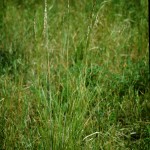Western Wheatgrass
Agropyron smithii
Poaceae
Description
Stems grow from gray, slender, creeping rhizomes. Stems and leaves are blue-green. The plant is often covered with a white coating which adds a silver color to the leaves and stems. Leaves are straight, broad, rough, and roll inward at maturity. The flat seed head is usually awnless. Glumes are asymmetrical. Its dense, narrow spikes occur at the top of the stout culms and range from 3 to 6 inches or 7.6 to 15 cm long. Western Wheatgrass is a perennial, cool-season, native ranging from 12 to 24 inches or 0.3 to 0.6 m tall. Good grazing for livestock. Fair grazing for wildlife. It is widely used for erosion control.Habitat
Western Wheatgrass is commonly found in western North America in low-lying areas, especially those with seasonal poor drainage. During times with high moisture, this species can become competitive with other neighboring grass and forb species. Native habitat includes hillsides, bottomlands, canyons, open woods, prairies, and scrublands. Soils include moist, alkaline clay, loam, and sand.Images
Plant Characteristics
Duration: Perennial
Stem Texture: Hairless/Smooth
Growth Habit: Grasses, Sod grass
Season: Cool
Distribution
 : 05 - Cross Timbers and Prairies, 07 - Edwards Plateau, 08 - Rolling Plains, 09 - High Plains, 10 - Trans-Pecos
: 05 - Cross Timbers and Prairies, 07 - Edwards Plateau, 08 - Rolling Plains, 09 - High Plains, 10 - Trans-Pecos
Distributions
Distribution refers to the ecological region in Texas that a plant has been found. You can also view a clickable map.
Book: Know Your Grasses (B-182)
Collection: Grasses



